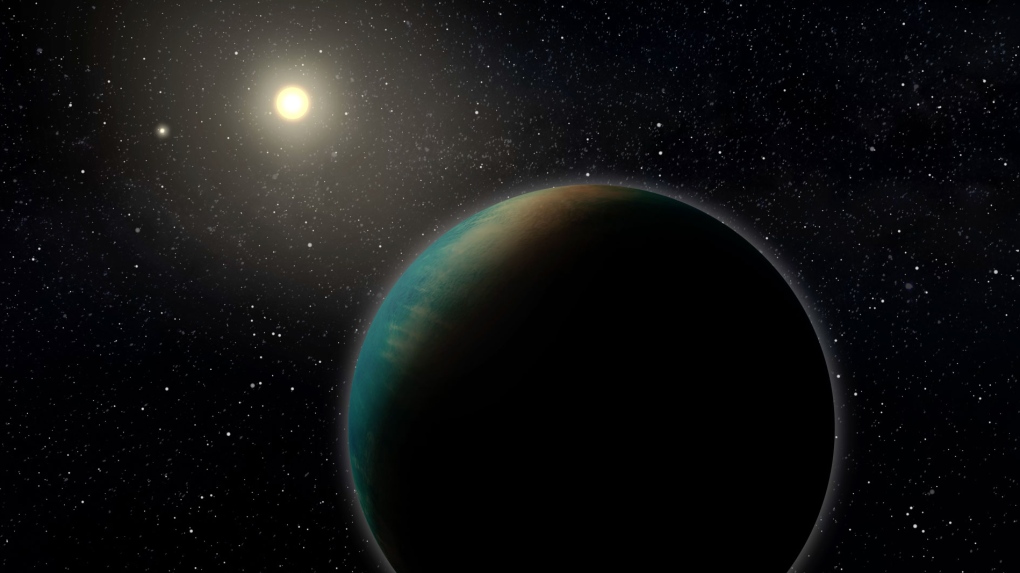Montreal researchers discover rare extrasolar 'waterworld'
A team of researchers led by a Montreal Ph.D. student has discovered a planet outside our solar system that has the potential to harbour life and that they believe is covered entirely in water.
The exoplanet is called TOI-1452 b and it orbits two stars in the not-so-far Draco constellation, about 100 light years from Earth.
NASA's TESS space telescope, which regularly surveys the sky for potential far-away planets, first signalled the floating rock, but it was Charles Cadieux from the Université de Montréal and his team who confirmed the planet's size and radius. It took them more than 50 hours to verify that what they were looking at was a planet about five times the size of Earth.
Further observation confirmed that even though this planet is much larger than Earth, it's far less dense, suggesting water could make up a decent proportion of its mass.
"So it looks very much like a planet that could be potentially a waterworld, something rocky, with a big ocean on it," said René Doyon, a Université de Montréal professor who guided Cadieux in his research.
Even though water covers 70 per cent of Earth's surface, it makes up less than 1 per cent of its mass. Comparatively, researchers believe TOI-1452 b could be made up of 30 per cent water, similar to Jupiter's moons Ganymede and Callisto and Saturn's moons Titan and Enceladus.
"So this is a very strange world that we've never encountered before," said Doyon, who is also the director of the Observatoire du Mont-Mégantic (OMM) in the Eastern Townships.
 René Doyon is a Université de Montréal professor and director of the Observatoire du Mont-Mégantic. (Joe Lofaro/CTV News)
René Doyon is a Université de Montréal professor and director of the Observatoire du Mont-Mégantic. (Joe Lofaro/CTV News)
The observatory's high-resolution PESTO telescope played a pivotal role in the discovery, confirming the planet's radius and that it orbits a binary solar system. Time goes by fast on this planet — one year is only 11 days.
Canadian technology played an even bigger role as the team used SPIRou, an instrument designed partly in Canada that measures low-mass stars.
Further analysis is needed to confirm more characteristics of the exoplanet, but Doyon said he is proud of what his team has determined so far.
"The ultimate goal is to find life elsewhere, and whenever you hear about the water, it's a key element for life to strive, at least as we know it on Earth," he said.
"On Earth, there's evidence that life may have started deep in the oceans ... and we know there's lots of life in there, even animal lives. And so, who knows, even though you don't have any continents, these ocean worlds may have life, striving deep in the oceans and maybe impacting their the atmosphere."
 The Observatoire du Mont-Mégantic, in Quebec's Eastern Townships, has a 1.6-metre telescope that was instrumental in confirming this discovery of TOI-1452 b. (Source: Émir Chouchane/Université de Montréal)
The Observatoire du Mont-Mégantic, in Quebec's Eastern Townships, has a 1.6-metre telescope that was instrumental in confirming this discovery of TOI-1452 b. (Source: Émir Chouchane/Université de Montréal)
For now, it seems promising that astronomers will be able to confirm this. The James Webb Space Telescope will be able to do further analysis year-round due to its location in the sky and proximity to Earth.
Cadieux and his team published their findings in The Astronomical Journal on Aug. 12. Researchers who contributed to the discovery are Mykhaylo Plotnykov, Guillaume Hébrard, Farbod Jahandar, Étienne Artigau, Diana Valencia, Neil J. Cook, Eder Martioli, and Thomas Vandal.
 Artistic rendition of the exoplanet TOI-1452 b, a small planet that may be entirely covered in a deep ocean. (Souce: Benoit Gougeon/Université de Montréal)
Artistic rendition of the exoplanet TOI-1452 b, a small planet that may be entirely covered in a deep ocean. (Souce: Benoit Gougeon/Université de Montréal)
CTVNews.ca Top Stories

W5 Investigates A 'ticking time bomb': Inside Syria's toughest prison holding accused high-ranking ISIS members
In the last of a three-part investigation, W5's Avery Haines was given rare access to a Syrian prison, where thousands of accused high-ranking ISIS members are being held.
'Mayday!': New details emerge after Boeing plane makes emergency landing at Mirabel airport
New details suggest that there were communication issues between the pilots of a charter flight and the control tower at Montreal's Mirabel airport when a Boeing 737 made an emergency landing on Wednesday.
BREAKING Supreme Court affirms constitutionality of B.C. law on opioid health costs recovery
Canada's top court has affirmed the constitutionality of a law that would allow British Columbia to pursue a class-action lawsuit against opioid providers on behalf of other provinces, the territories and the federal government.
Cucumbers sold in Ontario, other provinces recalled over possible salmonella contamination
A U.S. company is recalling cucumbers sold in Ontario and other Canadian provinces due to possible salmonella contamination.
Irregular sleep patterns may raise risk of heart attack and stroke, study suggests
Sleeping and waking up at different times is associated with an increased risk of heart attack and stroke, even for people who get the recommended amount of sleep, according to new research.
Real GDP per capita declines for 6th consecutive quarter, household savings rise
Statistics Canada says the economy grew at an annualized pace of one per cent during the third quarter, in line with economists' expectations.
Nick Cannon says he's seeking help for narcissistic personality disorder
Nick Cannon has spoken out about his recent diagnosis of narcissistic personality disorder, saying 'I need help.'
California man who went missing for 25 years found after sister sees his picture in the news
It’s a Thanksgiving miracle for one California family after a man who went missing in 1999 was found 25 years later when his sister saw a photo of him in an online article, authorities said.
As Australia bans social media for children, Quebec is paying close attention
As Australia moves to ban social media for children under 16, Quebec is debating whether to follow suit.


































